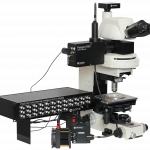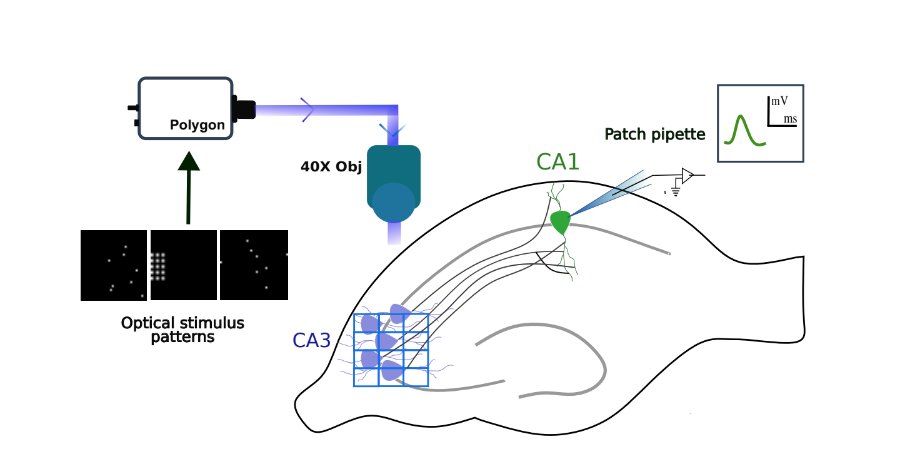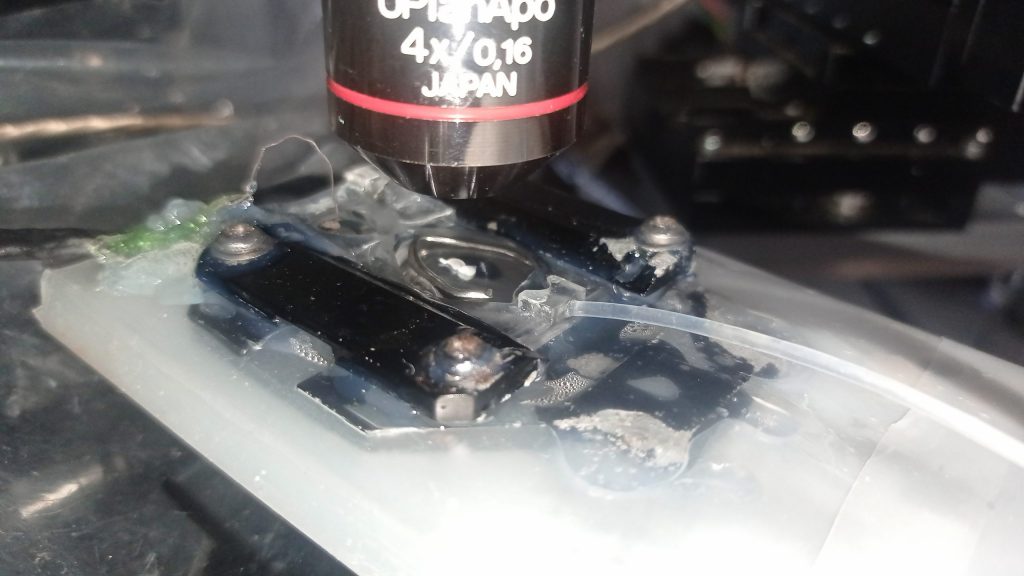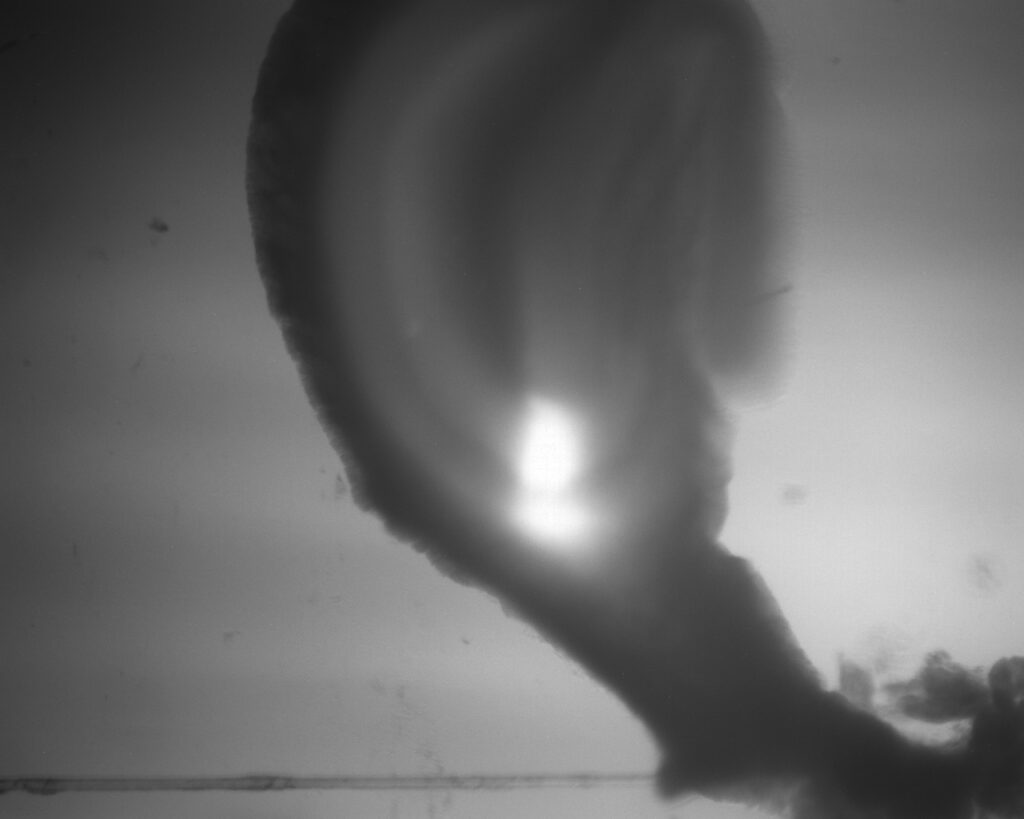Published on 2024/02/14 Research powered by Mightex’s Polygon1000 
 Sulu Mohan & Upinder S. Bhalla, Short-term plasticity in hippocampal CA1 synapses for different presynaptic activity patterns. Effect of in vivo like background activity on long-term synaptic plasticity. Bhalla Lab, National Centre For Biological Sciences, (2023).
Sulu Mohan & Upinder S. Bhalla, Short-term plasticity in hippocampal CA1 synapses for different presynaptic activity patterns. Effect of in vivo like background activity on long-term synaptic plasticity. Bhalla Lab, National Centre For Biological Sciences, (2023).


Research topic 1: Short term plasticity in hippocampal CA1 synapses for different presynaptic activity patterns
Flow of information through neuronal circuits occurs through junctions between neurons called synapses. The information gets filtered, gated and integrated in various ways during transmission between networks. Short term plasticity (STP) is the neuronal substrate for modification of the efficiency of synaptic transmission in the timescale of milliseconds to seconds. STP renders synapses the ability to process and integrate inputs which inturn controls information flow and processing in networks. Our work explored the diversity in short term plasticity of synapses in the hippocampal CA1 neurons. We also studied the integration of multiple synaptic inputs with diverse STP profiles in CA1 neuron that has balanced excitation and inhibition.
We performed invitro experiments on the CA3-CA1 network in acute hippocampal slices from mice expressing channelrhodopsin specifically in CA3 neurons. We achieved spatio-temporally patterned stimulation of randomly chosen sets of CA3 neurons using optogenetics with each spot in the pattern scaled to match the size of a CA3 cell body. Patterned light stimulation was carried out at the CA3 network while CA1 responses were recorded using whole-cell patch-clamp. Using patterned stimulation of CA3 network at specific intervals, we measured STP in different sets of synapses on CA1 neurons. We found STP profiles in CA1 synapses to be diverse within a CA1 neuron. Interestingly, this diversity in STP was correlated with initial weights of the synapses and their excitatory or inhibitory nature. By controlling the
number of spots in light patterns we looked at the summation of multiple inputs onto a CA1 neuron as well as the effects of STP on summation. Our results provide insights into the neuronal computation capabilities of CA1 cells with implications for timing, memory and excitation-inhibition balance of the CA3-CA1 network.
Research topic 2: Effect of in vivo like background activity on long-term synaptic plasticity
A parallel line of research I did as part of my PhD also explored the effect of in-vivo like spontaneous activity in the brain on memory and plasticity. We were able to standardise an all-optical protocol for induction of long-term plasticity (LTP) in hippocampal CA1 neurons using an optical theta-burst stimulation protocol. Optogenetics was used to induce theta-burst LTP optically as well as generate random activity that mimicked spontaneous invivo-like activity.
Mightex products used for optogenetics experiments:
We used the following products from Mightex to carry out the optogenetics experiments in both projects detailed above.
• Polygon400 Multiwavelength Patterned Illuminator
• BioLED Light Source Control Module (BLS-Series)
• PolyScan software

Figure 1: Schematic showing hippocampal slice with channelrhodopsin expression in CA3 neurons. CA3 neurons are stimulated in pre-defined ROIs using Polygon 400 and BioLED controller while electrical activity from CA1 neuron was recorded using patch clamp.
Mightex Application
Research topic 1: Short term plasticity in hippocampal CA1 synapses for different presynaptic activity patterns
We used the digital mirror device (DMD) technology of Polygon400 and BioLED Light Source Control Module (BLS-Series) from Mightex for the all experiments done as part of this project. Polygon was integrated into the light path of a DIC microscope objective and used to shine light on hippocampal slices in pre-defined CA1 CA3 40X Obj mV ms Polygon Optical stimulus patterns Patch pipette ROIs. The ability to trigger polygon with precise control of pulse timing, light intensity and frame rate were crucial in achieving reliable stimulation protocols.
Switching polygon frames was done using electrophysiology data acquisition systems used for patch clamping. This helped us control the timing of optical stimulation of CA3 relative to electrical recording of CA1 neurons with millisecond precision. In addition, patterned images generated using python could be uploaded to polygon software (PolyScan) in a pre-defined sequence.
Research topic 2: Effect of invivo like background activity on long-term synaptic plasticity
In order to induce theta-burst LTP in hippocampal slices in the presence of invivo-like background activity, each polygon frame was divided into ROIs. While one ROI was used to generate invivo-like background activity, another ROI was used to generate optical theta-burst stimulation when the frames were played in a sequence.
Independent control of switching polygon frames and triggering LED was crucial inorder to use close to a thousand frames at frame rates reaching upto 100 Hz. We were able to successfully standardise an LTP induction protocol that is physiological. This was possible because polygon met our requirements of a fast, precise and powerful light source that can induce theta-burst LTP.

Image 1

Image 2

Image 3
Video 1
Video 2
Video 3
Author: Sulu Mohan, PhD
Bio: Graduate Student (PhD), Prof. Upinder Bhalla’s lab, National Centre for Biological Sciences, Bangalore
Master of Science in Zoology, Central University of Kerala, Kerala
Bachelor of Science in Zoology, Mahatma Gandhi University, Kerala



